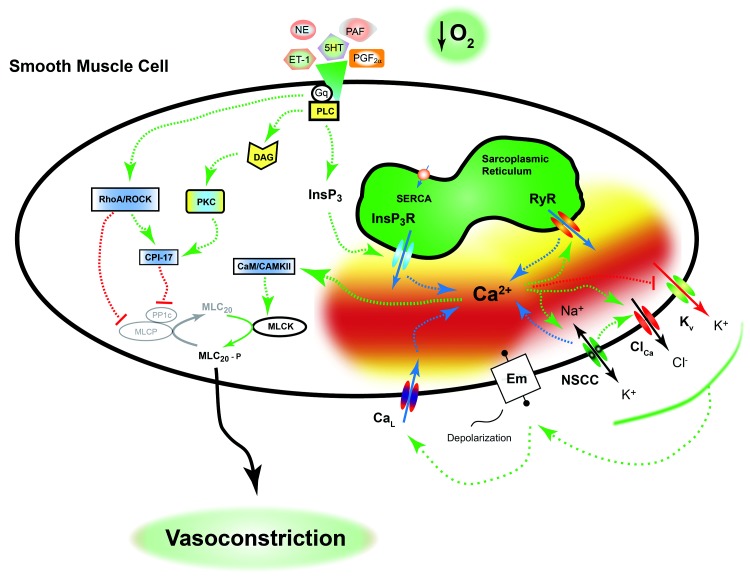Figure 1.
Pulmonary vasoconstriction is orchestrated. Neural, hormonal, and humoral mediators, as well as tissue hypoxia, constrict the lung vasculature in utero and maintain a high level of fetal pulmonary vascular resistance. Many of these agonists work through a Gq-coupled receptor pathway to activate a number of intracellular signaling systems that lead to pulmonary vascular smooth muscle cell contraction. These pathways are detailed in the text and ultimately cause simultaneous activation of myosin light-chain kinase (MLCK) and inhibition of myosin light-chain phosphatase (MLCP). The mechanisms associated with hypoxia-induced pulmonary vasoconstriction are controversial but overlap those of the other mediators. Adult animal studies illustrate that the hypoxia-induced pulmonary vasoconstriction response includes a combination of activation of L-type Ca2+ channels (CaL), ryanodine receptors (RyRs), Rho-kinase, nonselective cation channels, and inhibition of K+ channels. A dashed green arrow indicates an activation pathway; a dashed red line with a bar indicates an inhibition pathway; a dashed blue arrow indicates movement of calcium. CaM/CAMKII: calmodulin and Ca2+/calmodulin-dependent protein kinase II; ClCa: calcium-activated chloride channel; CPI-17: C-kinase potentiated protein phosphatase-1 inhibitor; DAG: diacylglycerol; Em: membrane potential; ET-1: endothelin-1; Gq: q alpha subunit of G protein–coupled receptor; InsP3/InsP3R: inositol 1,4,5 triphosphate and associated receptor; Kv: voltage-dependent potassium channel; MLC20/MLC20-P: 20-kDa myosin light chain and phosphorylated moiety; NE: norepinephrine; NSCC: nonselective cation channel; PAF: platelet-activating factor; PGF2α: prostaglandin F2α; PKC: protein kinase C; PLC: phospholipase C; PP1c: protein phosphatase-1c; RhoA/ROCK: Ras homolog gene family, member A, and associated kinase; SERCA: sarco/endoplasmic reticulum Ca2+-ATPase; 5-HT: serotonin.

